A while back, a good friend wrote to tell me that an exhibition of the Japanese tea ceremony (chanoyu) was to take place at the British Museum. Excited, having never been to a real chanoyu, I made plans to attend. My schedule buckled under the weight of a host of unexpected meetings on the day, and I was thwarted. No trip to London.
"Here's another chance!" wrote the same ever-generous friend, with details of a repeat performance. As if by magic, the meetings I had scheduled for the day all evaporated one by one, leaving me looking at a beautiful, blank square in my Google Calendar. It was meant to be!
I booked a day's leave, and headed out with Lei for the capital.
"Here's another chance!" wrote the same ever-generous friend, with details of a repeat performance. As if by magic, the meetings I had scheduled for the day all evaporated one by one, leaving me looking at a beautiful, blank square in my Google Calendar. It was meant to be!
I booked a day's leave, and headed out with Lei for the capital.
I try not to get down to London too often as it's a bit tough, but aim to make it to Teasmith when I do. (My previous notes on John's fine shop are hither and thither.)
It's a rare thing, to see a shop based entirely on proper tea. We have "Betty's Tea-Room" in Harrogate (of Taylors of Harrogate infamy), which is an old-fashioned place selling decent tea served English-style; we have various grand hotels offering "afternoon tea"; and we have Teasmith. To my knowledge, that's it as far as real tea in England goes. Most other venues serve up below-average teas, put a romantic name on them, and, if you're lucky, sell bottom-shelf factory Yixing for excruciating prices.
Not much has changed at Teasmith, with the exception that the menu of teas reads surprisingly like the Teamasters product list. No bad thing, as I happen to like Stephane's wulong. Red Taiwanese wulong, Dayuling, the same ages and grades as Stephane - even Stephane's method of naming certain teas using altitudes of mountains. Surely no coincidence!
Things have become a little more pricey at Teasmith, sometimes disconnected with the quality of the tea. Approx. 100ml of matcha fluid costs the princely sum of £5, which is enjoyed in just a few sips. A nice-but-unenthralling wet-stored 2003 Manzhuan shengpu from the "Yunnan Xishuangbanna Yiwu Tea Factory" goes for £7 for three infusions. (The very pleasant lady behind the counter informed me that these cakes cost £300-£350 pounds each. I remained tactfully silent. "Is that expensive?" she asked.)
"Nice to experience, but I wouldn't pay these prices regularly", confided Lei when we were gone. However, I'm glad the shop is still going, and if prices need to be raised to keep it afloat in these troubled times then so be it. Besides, their local community consists mostly of bankers, who earn considerably more than humble junior academics, so I suspect I'm more sensitive to it than most.
The renaming of teas is a tad confusing. I can understand that there's a need to translate Chinese terms into English, but the original sense of the names is not being retained, making it very difficult for people to know what they're drinking in real terms. Exacerbating this difficulty, the very enthusiastic members of staff are trying hard to learn as much as they can about tea (a good thing), but they're learning the names invented by the shop. I had the following conversation with the bar-lady:
Step outside the shop, and all the invented names are hard to relate to real tea. For instance, what would you say is "Phoenix Supreme"? (Answer: Fenghuang Dancong, noting that Fenghuang means "Phoenix", referring to the southern moutain range, but where the tea is usually called Dancong.)
Teasmith are doing a sterling job in bringing about tea awareness, but I wouldn't object if they made the naming a little more transparent, so that people are learning real tea-names.
It's a rare thing, to see a shop based entirely on proper tea. We have "Betty's Tea-Room" in Harrogate (of Taylors of Harrogate infamy), which is an old-fashioned place selling decent tea served English-style; we have various grand hotels offering "afternoon tea"; and we have Teasmith. To my knowledge, that's it as far as real tea in England goes. Most other venues serve up below-average teas, put a romantic name on them, and, if you're lucky, sell bottom-shelf factory Yixing for excruciating prices.
Not much has changed at Teasmith, with the exception that the menu of teas reads surprisingly like the Teamasters product list. No bad thing, as I happen to like Stephane's wulong. Red Taiwanese wulong, Dayuling, the same ages and grades as Stephane - even Stephane's method of naming certain teas using altitudes of mountains. Surely no coincidence!
Things have become a little more pricey at Teasmith, sometimes disconnected with the quality of the tea. Approx. 100ml of matcha fluid costs the princely sum of £5, which is enjoyed in just a few sips. A nice-but-unenthralling wet-stored 2003 Manzhuan shengpu from the "Yunnan Xishuangbanna Yiwu Tea Factory" goes for £7 for three infusions. (The very pleasant lady behind the counter informed me that these cakes cost £300-£350 pounds each. I remained tactfully silent. "Is that expensive?" she asked.)
"Nice to experience, but I wouldn't pay these prices regularly", confided Lei when we were gone. However, I'm glad the shop is still going, and if prices need to be raised to keep it afloat in these troubled times then so be it. Besides, their local community consists mostly of bankers, who earn considerably more than humble junior academics, so I suspect I'm more sensitive to it than most.
The renaming of teas is a tad confusing. I can understand that there's a need to translate Chinese terms into English, but the original sense of the names is not being retained, making it very difficult for people to know what they're drinking in real terms. Exacerbating this difficulty, the very enthusiastic members of staff are trying hard to learn as much as they can about tea (a good thing), but they're learning the names invented by the shop. I had the following conversation with the bar-lady:
We dig out the product notes, which read, in Chinese, "Dahongpao". Difficult.
"I like this one - is it yancha?"
"No, this is Wuyi Dark Rock."
"But surely it's a Wuyi yancha - perhaps Dahongpao?"
"No, Wuyi Yancha is this one." (Shows another canister of yancha.)
Step outside the shop, and all the invented names are hard to relate to real tea. For instance, what would you say is "Phoenix Supreme"? (Answer: Fenghuang Dancong, noting that Fenghuang means "Phoenix", referring to the southern moutain range, but where the tea is usually called Dancong.)
Teasmith are doing a sterling job in bringing about tea awareness, but I wouldn't object if they made the naming a little more transparent, so that people are learning real tea-names.
Onto the British Museum, one of the shining jewels in the darkened crown which is London. This is a museum of the old school (pictured above), and is all the better for it: tons of extraordinarily rare artifacts of the kind that you see immortalised in books and posters throughout popular culture. The British Museum is rather awesome.
I've not been here for many years, which I realised when stepping through to the main courtyard (above), which has been transformed into something unfamiliar - but beautiful. For the year 2000, we wasted tons of national money building all sorts of architectural horrors (such as London's Millenium Dome). This courtyard testifies to the fact that some nice works were also completed. The huge courtyard has been capped in a dome, with a lovely cylindrical centre structure. Everywhere is "big" and hushed, like some vast library - yet so light and open.
Head into the side-buildings, and it's back to the traditional comfort of oak panels (below).
Head into the side-buildings, and it's back to the traditional comfort of oak panels (below).
The only thing missing in the British Museum is British people. It seems that everyone here is a tourist from abroad. I had rather hoped to see crowds of local schoolchildren running around, and all sorts of folk taking the valuable opportunity to see some genuinely breathtaking exhibits. Then again, perhaps they're all just working, as it is a week-day...
Into the Japanese Galleries, funded by the Mitsubishi Corporation - and well they did, for it's a valuable insight into Japanese life through the ages. There was even a beautiful series by Hiroshige (including the Shower over Atake Bridge - fans of Van Gogh please click the link), and the famous Kanagawa wave by Hokusai.
The tea ceremony allowed no photographs, but I took a parting photo after everyone had left, shown above. It was more in the spirit of a school class than a breathtaking exercise in chadao, but the graceful motions of the host left me feeling peaceful. And resolved to drink more matcha.
The tea ceremony allowed no photographs, but I took a parting photo after everyone had left, shown above. It was more in the spirit of a school class than a breathtaking exercise in chadao, but the graceful motions of the host left me feeling peaceful. And resolved to drink more matcha.
On the way out, we noticed a current exhibition of pieces borrowed from a famous Shanghai museum. The above piece was created around 4,000 b.c. Lei likes to remind me that the British were highly uncivilised at that point, and that the Chinese were already producing fine works of sculpture.
Above, some works from the Zhou Dynasty, dated a little older than the Buddha. Staggering.
I have some matcha-ware coming our way from Japan as a result of this trip, so look forward to recreating a little of Uji magic in our own house. I don't think I can manage a full chanoyu ceremony, but I'm probably capable of whisking tea. How different can it be to whisking up your Blenheim Bouquet with a Simpsons?

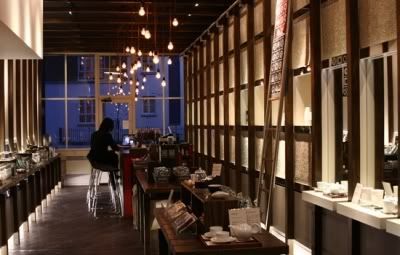


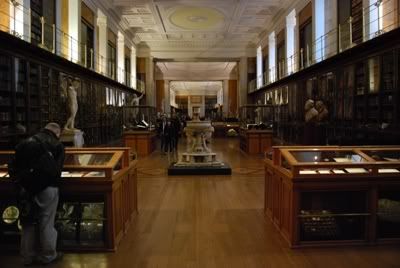
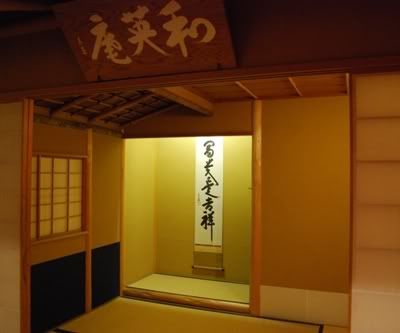
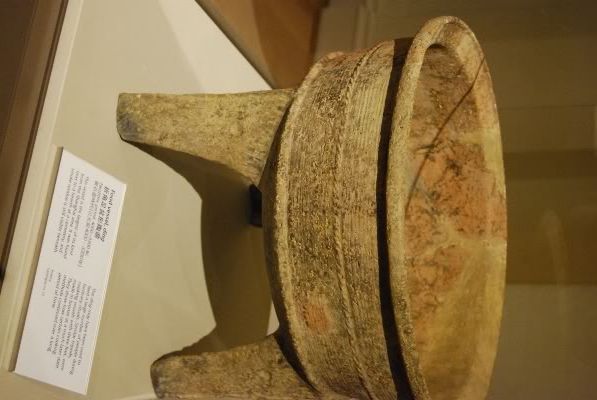
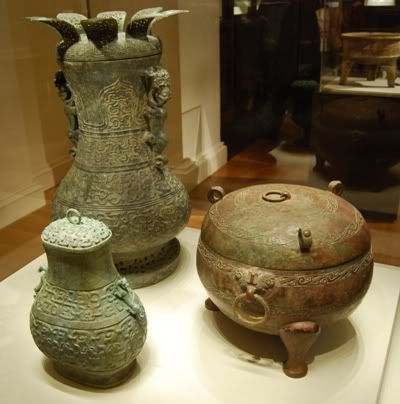
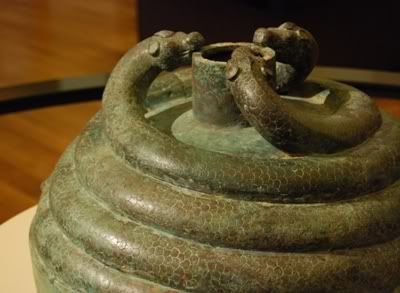
6 comments:
David, nice reminder of the museum. “Many moons have passed” since my last visit. (97ish) I think it only appropriate, that no photography be allowed. Regards john
Yes, I hate places that rename tea for their convenience. You end up not knowing anything at all about what you're actually drinking...
Then again, even if the original name is retained, it often means nothing. Not all dahongpaos are created equal
Dear John,
Time you went back, methinks. :)
Dear MarshalN,
True enough. I think it's damaging to the long-term prospects, actually, and so works against the shops.
Some of the American outlets, and Whittards (if they're still going), used to make this problem much worse by entirely re-inventing the names, as I'm sure you know. When customers feel they're being babied, it must have a negative effect.
For example, I'm trying to imagine the effect if wines were renamed by the vendors - no-one would know what they're drinking, and they would presumably gravitate towards proper wineries, that retain the original names.
I think "dahongpao" can be used analagously to "Bordeaux". It defines a gamut of wines, none too specifically, but enough to give you the idea. More a genre, than a definition.
Toodlepip,
Hobbes
Hello Hobbes,
Thank you for the informative post on tea purveyors in London. Great museum pictures!
Have a good day.
Alex
Beautiful photographs to go along with the great prose. Thanks!
I agree that renaming teas is a bad idea: Yes there is going to be a wide difference in quality between even teas of the same name, but as Hobbes notes, at least the name can serve as a guide.
Dear Lainie,
Thank you for the comment; I'm glad that you enjoyed the article. Your first comment here, I believe, so welcome!
Toodlepip,
Hobbes
Post a Comment